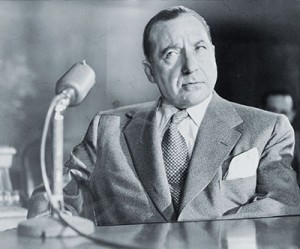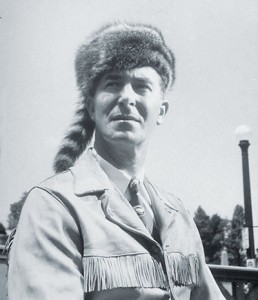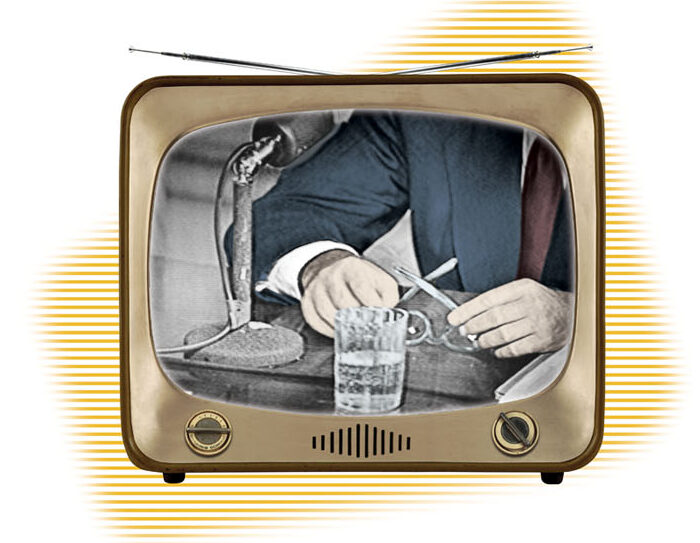Television’s most exciting programming in March 1951 featured two hairy hands fidgeting as a disembodied voice with a gruff New York accent answered questions—or, more often, dodged them.
That may not sound like appointment TV, but the images and voiceover fascinated more than 20 million American viewers. The hands and voice belonged to Frank Costello, “the Prime Minister of the Underworld.” The mob boss was testifying before the U.S. Senate Special Committee to Investigate Crime in Interstate Commerce, which was airing its latest round of hearings live on the brand-new medium. Though few households owned TVs, people crowded bars and restaurants that did to follow the inquiry. Often more than one station in a market carried committee sessions in their entirety.
“Millions Glued to TV for Hearing,” a New York Times headline read. “Home Chores Wait, Shopping Sags.”

Costello’s unwilling guest appearance was hyped by a master of self-promotion—freshman Senator Estes Kefauver, the panel’s chairman. The Tennessee Democrat had become famous as a trust-busting New Dealer in the House of Representatives and for campaigning in a coonskin cap. Starting in May 1950, Kefauver took his new committee on the road, staging 14 hearings in such cities as Miami, New Orleans, Kansas City, Las Vegas, and Chicago. At every stop, panel members grilled gangsters, gamblers, crooked cops, and corrupt pols, many of them colorful characters—Jake “Greasy Thumb” Guzik and Tony “The Enforcer” Accardo and a sleazy Florida sheriff known as “Melon Head.”
By the time the roadshow reached New York, the committee had amassed ample evidence that organized crime controlled many politicians and policemen. And the boss of organized crime—the boss of all bosses—was Frank Costello.
“That wily string-puller,” Kefauver called Costello. “When he talks, underworld characters—and even some not directly in the underworld—listen.”
Kefauver subpoenaed Costello to talk to the committee in New York, Costello’s home and the hub of American media. Costello was not thrilled; he hated publicity. The dapper 60-year-old lived in a luxurious apartment overlooking Central Park, dressed in elegant suits, smoked English Oval cigarettes, hung out in the Waldorf Astoria barbershop, and golfed with lawyers, businessmen, and politicians. Born in Italy and raised in New York, he served 10 months on a gun charge in 1915, and in 1925, the year he became a U.S. citizen, was indicted for bootlegging. But he beat the booze charge and hadn’t been arrested since. Costello claimed to have reformed himself into respectability, but he was America’s overlord of organized crime—not that he wanted to say so on live television.
“Mr. Costello doesn’t care to submit himself as a spectacle,” his lawyer, George Wolf, told the committee as soon as Costello sat in the witness chair. Costello was willing to testify, Wolf said, but not to show his face onscreen. The committee reluctantly decreed that cameras had to keep off Costello’s face. Peeved, TV camera operators pushed in on the mobster’s hands, which he held in front of himself on the table, fingers fiddling nervously.
After Costello swore to tell the truth, Rudolph Halley, the committee’s interrogator, asked if the witness had ever used the name “Severio.”
“I might have used it,” Costello said.
“I will not accept that answer,” Halley said. “Did you or did you not use it?”
“Well, I don’t know,” Costello said. “I won’t say I didn’t.”
“You were convicted of a crime under that name, were you not?”
“Thirty-five, thirty-six years ago, yes,” Costello admitted.
Halley was asking about the alias because on his 1925 naturalization papers, Costello had sworn that he used no aliases. Lying on citizenship papers was punishable by deportation. Halley then revealed that on Costello’s naturalization papers, he had given as his occupation “real estate.”
“You were in the liquor business at that time, were you not?”
“I don’t believe so,” Costello said.
Halley reminded the witness that in 1925 he’d been indicted for bootlegging.
“I wasn’t convicted, was I?” Costello said.
“No.”
“Then I wasn’t in the bootlegging business.”
Halley noted that on the citizenship form one Harry Sausser had vouched for Costello. Identified in the paperwork as a “railroad man,” Sausser was actually a bootlegger. Costello told Halley that the bootlegging Harry Sausser was a different person than the railroading Harry Sausser.
“How many Harry Saussers did you know?” Halley asked.
“I don’t know,” Costello replied. “I might have known two or three.”
“You knew three? Do you expect this committee to believe that story, Mr. Costello?”
“I am not expecting you to believe anything. I knew you weren’t going to believe anything when I came here. I have been prejudged.”
As Costello struggled to parry Halley’s jabs, TV viewers watched his hands drumming nervously and twisting a sheet of paper.
Halley changed subjects to Costello’s tax returns, which portrayed a delightfully cushy working life. At one job, Costello made $18,000—today, $170,000—as an employee of the Beverly Country Club, a nightclub and casino in New Orleans, Louisiana.
“What did you do for that money, Mr. Costello?”
“I was just a goodwill man for them. And I would recommend different acts for the club.”
“What acts did you recommend?”
“Well, Joe Louis, Sophie Tucker, and a lot of big acts.”
“And for that you got $18,000 a year?”
“That’s right.”

Costello made another $15,000 a year—today, $142,000—working for a Long Island racetrack. What did he do? “Practically nothing,” Costello said; he simply spread the word that bookies were unwelcome at the track. He made $25,000 ($237,000) promoting a brand of Scotch whisky a friend imported, an arrangement that required him to drink the Scotch in fancy Manhattan saloons and recommend the product to pals.
Costello’s testimony was implausible but entertaining, and his hands proved telegenic. “When the questions got rough, Costello crumpled a handkerchief in his hands. Or rubbed his palms together. Or interlaced his fingers,” the New York Times reported. “His was video’s first ballet of the hands.”
During a second long day of testimony, Costello told the committee he had a sore throat and he couldn’t continue. His lawyer said if he were forced to keep talking, Costello might expire.
“You refuse to testify further?” Kefauver asked his grouchy witness.
“Absolutely,” Costello declared. Then he walked out of the hearing.
He returned a few days later and answered more questions. When committee members demanded he reveal his net worth, Costello, fearing a tax evasion charge, refused. The feds nailed him for contempt of Congress, and eventually sent him to prison for 18 months.
The hearings made Kefauver a crime-busting hero. In 1952, he ran for president, winning 14 of 16 Democratic primaries. However, by exposing big-city Democratic machines’ ties to the Mafia, he had angered party bosses, including President Harry Truman, who privately called Kefauver a “demagogic dumbbell.” The Democrats instead nominated Adlai Stevenson.
Released from prison in 1957, Costello moved back into his Manhattan apartment. One evening, he strolled into the building’s lobby to encounter Vincent Gigante, another gangland figure. Gigante, known as “The Chin,” shot Costello in the head.
“This is for you, Frank!” the hit man said.
The Chin’s slug didn’t kill the crime boss, but Costello refused to testify against his attacker and Gigante beat the rap. Costello soon retired. He was 82 when he died of natural causes in 1973—a year after Marlon Brando played a mob boss based on him in The Godfather. ✯
This story was originally published in the September/October 2016 issue of American History magazine. Subscribe here.





